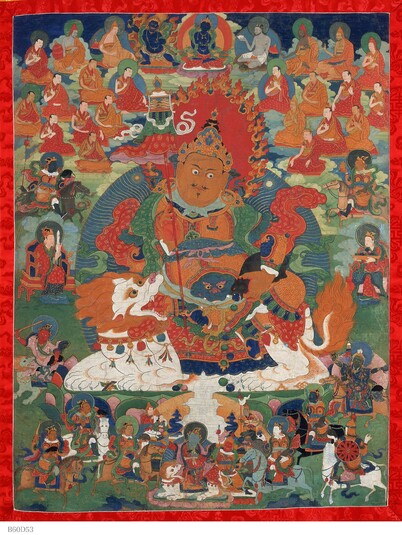
Item: Vaishravana (Buddhist Protector) - Riding a Lion
| Origin Location | Tibet |
|---|---|
| Date Range | 1600 - 1699 |
| Lineages | Buddhist |
| Size | 88.90x66.04cm (35x26in) |
| Material | Ground Mineral Pigment on Cotton |
| Collection | Asian Art Museum of San Francisco |
| Catalogue # | B60D53 |
Classification: Deity
Appearance: King
Gender: Male
Vaishravana (Tibetan: nam to se. English: the Son of Namto): Guardian King, God of the Northern Direction.
Tibetan: Nam to se
With a stern look and large staring eyes, one face and two hands, he holds in the right a victory banner of variously coloured fluttering silks - a gift of the gods. The left holds to the side a black mongoose spitting a flood of coloured jewels. Adorned with a gold and jewel crown, earrings, body armour of gold, garments of various colours, pants and boots, he sits in a relaxed posture with the right leg extended atop a white snow lion. Seated above a white moon disc and multi-coloured lotus he is surrounded by a blue nimbus and red aureola with orange flames.
At the top center is Vajradhara, the primordial buddha. To the left is the wrathful bodhisattva Vajrapani, blue, with one face and two hands holding a vajra and lasso. Indian and Tibetan teachers of the transmission lineage descend on the right and left.
With two at the top and six more at the bottom, eight attendant horsemen accompany Vaishravana. Wearing the garb of warriors each has their own colour, unique object in the right hand, a mongoose in the left and ride on a horse. At the lower right.
"With vajra armour, a garland of jewel ornaments and the beautiful heavenly banner - fluttering, illuminated in the middle of a hundred thousand Wealth Bestowers; homage to Vaishravana, chief among the protectors of the Teaching." (Nyingma liturgical verse).
Vaishravana, leader of the Yaksha race, is a worldly guardian worshipped as both a protector and benefactor. He, with his wife - a naga princess, lives on the north side of the lower slopes of mount Meru in the Heaven of the Four Great Kings in a sumptuous palace bathed in green emerald light. As the leader of the Four Direction Guardians, he at the head of the others, swore an oath of protection before the buddha Shakyamuni. The stories and iconography of the Four Guardians arise primarily from the Mahayana Sutras and are common to all schools of Tibetan Buddhism. Lord Atisha popularized the meditation practice of Vaishravana in the 11th century.
Jeff Watt 10-98 [Updated 5-2009]
Collection of Asian Art Museum of San Francisco
Collection of Asian Art Museum of San Francisco (Masterworks)
Buddhist Deity: Vaishravana Riding a Lion (Masterworks)
Subject: Wealth Deity Videos
Collection of Asian Art Museum of San Francisco (Shalu Selection Masterworks)
Collection of Asian Art Museum of San Francisco (Sakya Selection Masterworks)
Buddhist Worldly Protector: Vaishravana Riding a Lion
Tradition: Shalu/Bulug Main Page
Subject: Protectors - Worldly Protectors Considered Wisdom Deities
Buddhist Worldly Protector: Vaishravana (Painting Masterworks)
Subject: Mongoose Symbolism
Subject: Masterworks (Male Deity Protectors, 男性护法神, སྲུང་མའི་ཚོགས། [ཕོ་])
